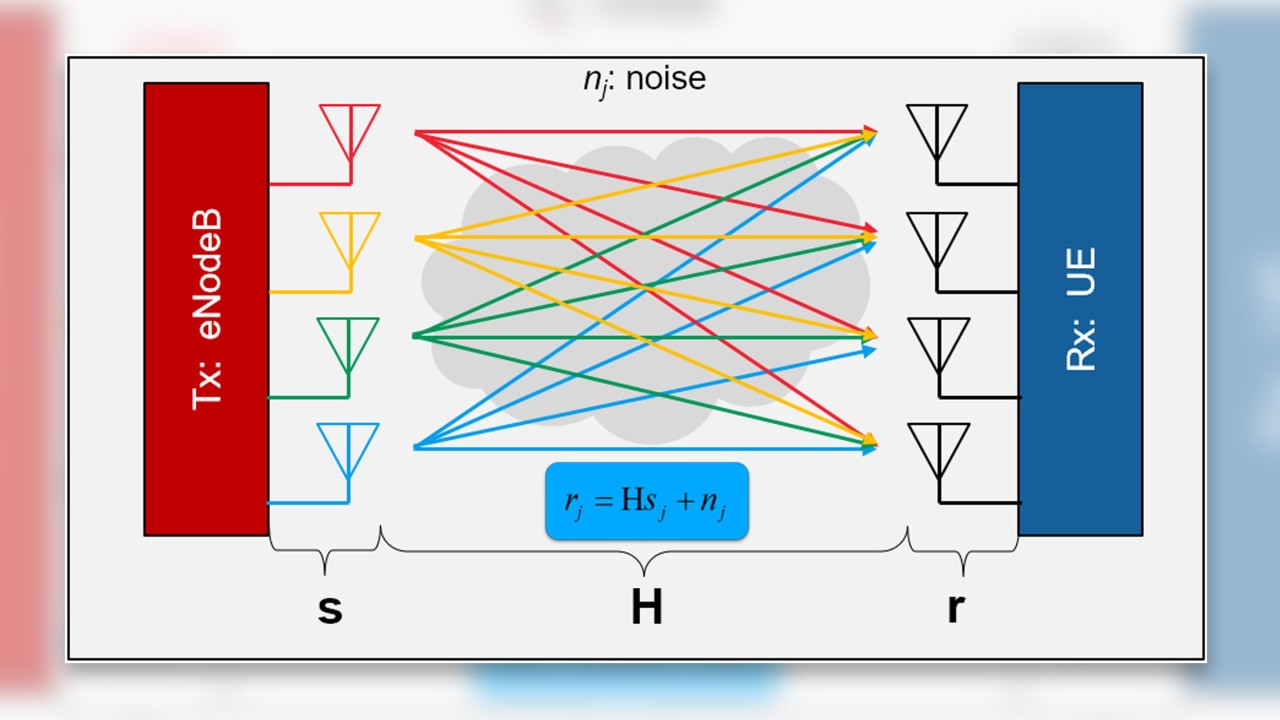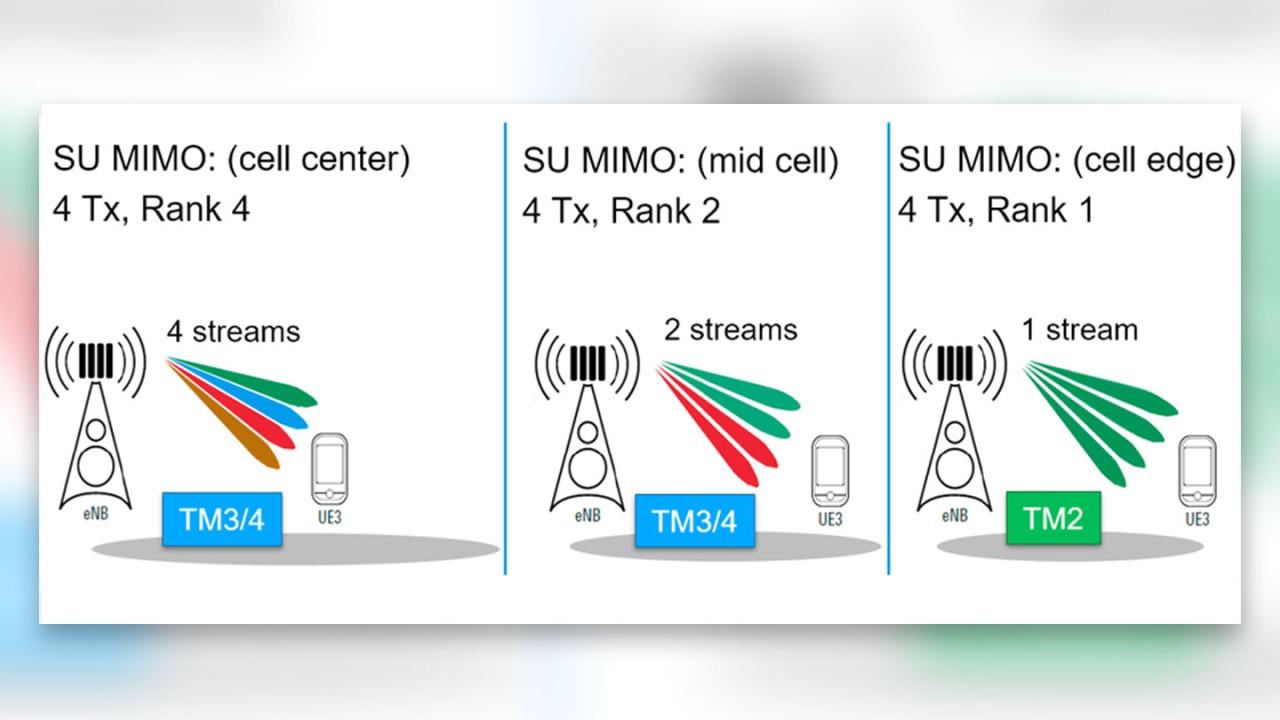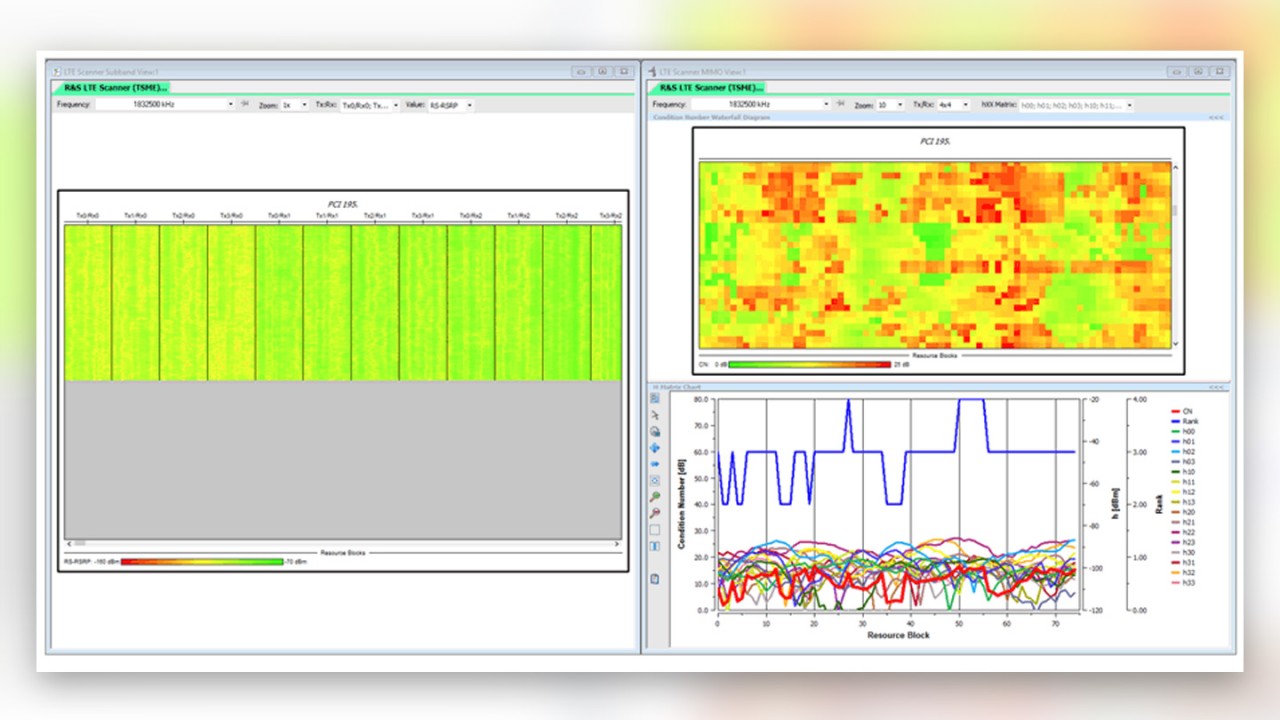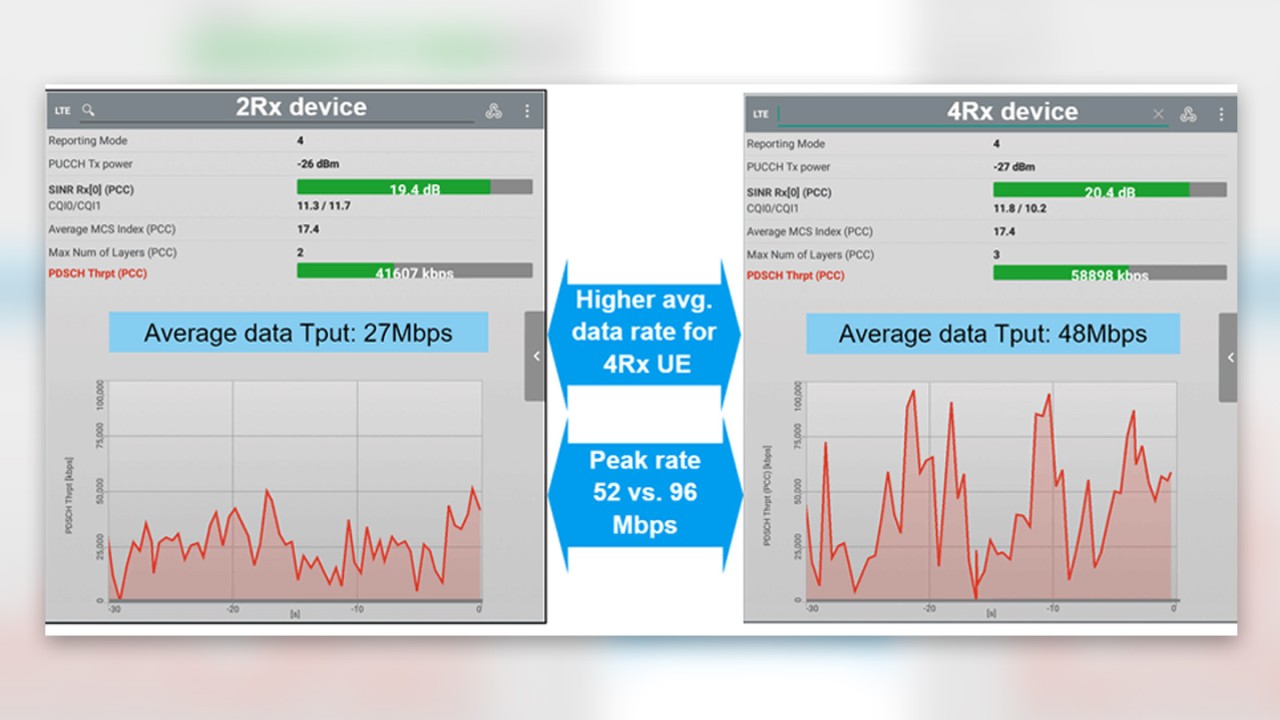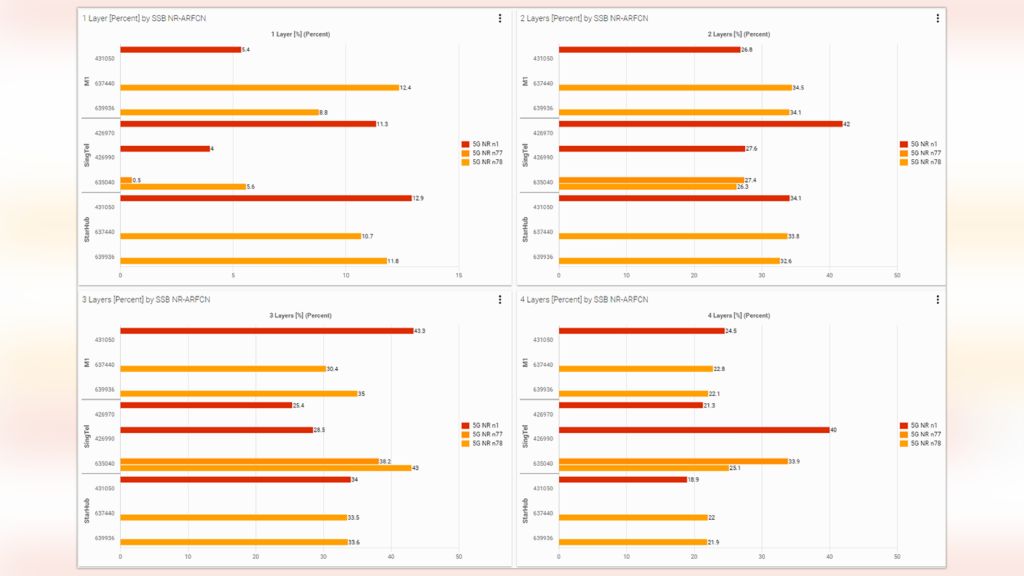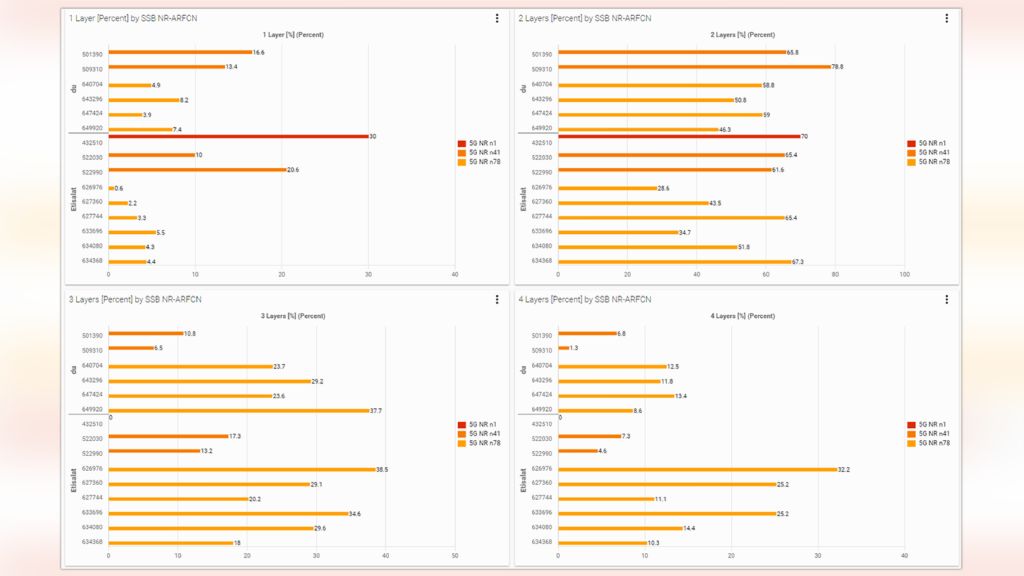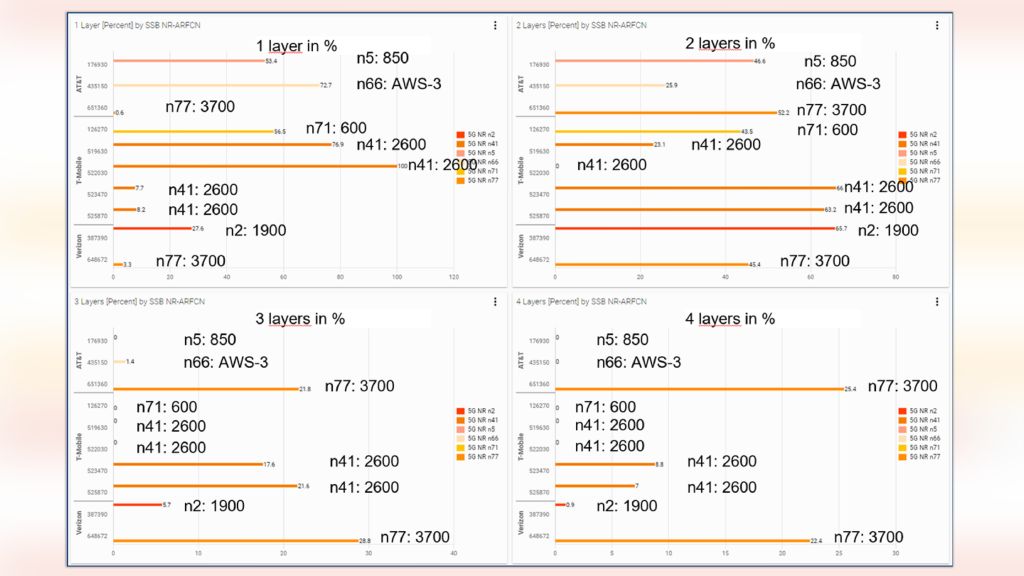Written by Michael Lorenz | July 4, 2018, updated by Arnd Sibila | September 6, 2024
Introduction
5G deployments in mid-band spectrum (> 1GHz) in the sub-6 GHz bands have the most options when it comes to the radio configuration. Choices range form 2T2R to 64T64R, different from the sub-1 GHz band where only 2T2R or 4T4R is viable due to size of wavelength, or in mmWave bands where Massive MIMO is essential for outdoor macro deployments to ensure sufficient coverage. This is only the downlink view since smartphones are always battery power limited and consequently use just 1Tx in UL in most cases.
This story focuses on frequencies < 3GHz and 4T4R radios. Massive MIMO and beamforming will be discussed in other publications to come.
4x4 MIMO
Four Tx antennas at the base station (eNodeB) site and four Rx antennas in the user equipment (UE) are the prerequisite for 4×4 MIMO deployments. 4 different signals (layers) are transmitted by the 4 transmit antennas (eNodeB) and received by 4 Rx antennas of the UE. The antennas at each site (eNodeB and UE) have to be uncorrelated to provide independent paths as a baseline for up to four different data channels at the same time. Early LTE networks offer 2×2 MIMO features with a maximum of two different data streams simultaneously. The number of allocated data streams is known as “layers”, the rank of the channel matrix as “rank”.
As precondition the channel should offer a sufficient multipath richness, i.e. the channel needs to allow for up to 4 uncorrelated paths that is often given in urban environment (e.g. due to reflection on buildings etc.). In rural areas we normally can expect only 2 paths due to lack of additional reflections.
Gain potential of 4×4 antenna configuration
What are the potential improvements of a 4×4 MIMO deployment in general? With good radio conditions (high SINR) at the cell center, 4×4 MIMO will definitely double the peak data rate because four independent data streams are used instead of two.
Moving away from the cell center towards the cell edge, radio conditions will degrade at a certain point reducing the number of ranks to 3 or 2. In the rank 2 area, let’s call it “mid cell”, it is possible to transmit the same data stream over multiple antennas, as shown in the picture. This transmit diversity gain will increase the data throughput compared to a 2×2 scenario at the same location.
At the cell edge rank 1 is used, i.e. one signal is transmitted by all 4 Tx antennas and received by 4 RX antennas in the smartphone. This transmit / receive diversity gain increases the data performance at the cell edge. A gain of roughly 3dB compared to 2 Rx antennas is huge at the cell edge and can multiply the achievable DL data throughput.
eNodeB and UE deployment challenges
Today, cross-polar antennas are deployed in traditional 2×2 MIMO networks. To add uncorrelated third and fourth antennas to the system, a second cross-polar antenna can be used. Horizontal or vertical spacing is needed for the decorrelation.
In case of horizontal spacing a distance d ≥ 10λ is required theoretically which calculates to a distance of 1.7 m for 1800 MHz between the two columns. Such a deployment is highly unlikely in most markets (wind load, visual impact) and therefore new dual cross-polar antennas are developed and used.
This results in a trade-off between a good decorrelation of both antennas (d ~ 1λ) and a small form factor. Even if the feeder lengths are similar, the risk of mismatching the correct antenna ports of such multiport antennas (antennas with up to 16 ports are commercially available today) remains high.
The bigger challenge, however, is the integration of 4 Rx antennas into a device (smartphone). Even with the size of smartphones, 4 Rx antennas support only the LTE high bands (1700 – 2600 MHz). However, whether a device supports 4×4 MIMO depends on the UE capability controlled by the
- built-in antennas,
- chipset,
- firmware,
- and SIM card profile.
Evaluating and validating 4×4 MIMO networks with network scanners
Scanners offer an optimal approach to evaluate and validate 4×4 MIMO LTE networks because the LTE standard offers Reference Signals (RS) for all 4 Tx antennas of a base station. Thus, the scanner can distinguish between the BS antennas.
Non-intrusive network scanners bypass the uncertainty of devices (smartphones). First, the network performance should be validated with scanners that do not need SIM cards. For a true 4×4 measurement (rank and condition number), 4 receivers (scanners) and 4 Rx antennas are needed to measure and determine the so-called H-matrix of the 4×4 setup, including the 16 individual paths Tx_i/Rx_j (i,j = 0, 1, 2, 3).
By solving these linear equations, the rank and condition number are derived. The rank represents the maximum number of possible independent layers that the channel matrix offers and the condition number is a measure for channel quality. Condition numbers are dependent on the rank and cannot be compared between different ranks.
Network scanners from Rohde & Schwarz, such as the R&S®TSME6 or R&S®TSMA6, are ideal for scanner-based health check measurements. The detailed LTE scanner sub-band view (left) visualizes the individual 16 Tx_i/Rx_j measurements (RS-RSRP, RS-SINR or RS-RSRQ) for the full bandwidth and all resource blocks (RB). Abnormal behavior directly pinpoints the problem, e.g. poor antenna installation, insufficient decorrelation or even faulty antenna paths.
The LTE scanner MIMO view (right) displays the color-coded condition numbers (green: good; red: bad) for the entire spectrum (upper right). It also shows the individual hxy elements of the H-matrix and the rank and condition number per resource block (lower right). Condition numbers can be compared only for the same rank and not between different ranks.
Mobile measurements are essential to get the true end-user experience.
Based on sub-band measurements, the universal drive test software ROMES calculates an estimated CQI and throughput per layer and resource block. The scanner is able to decode the BCH messages without using a SIM card. Therefore, the number of deployed Tx ports, which is part of the MIB/SIB messages, is decoded per measured cell.
Please note that the 5G standard eliminated the reference signals per BS Tx antenna for enhanced spectral efficiency. Scanners cannot be used to execute all these 4x4 MIMO measurements in 5G because the different BS Tx antennas could not be identified and separately measured.
Smartphone-based 4x4 MIMO measurements
Mobile measurements are essential to get the true end-user experience. The QualiPoc Android handheld test and troubleshooting solution is based on modified commercial smartphones using Qualcomm or Samsung chipsets. Beside various KPIs, all layer 1 to layer 3 information and messages can be traced for a deep dive analysis. RF measurements per Rx antenna in combination with carrier aggregation, used modulation schemes, rank information and the resulting throughput are only a few of the available information elements.
The network boost through 4×4 MIMO is evaluated by comparing a 2Rx vs. 4Rx device in the same 4×4 MIMO LTE network. As described earlier, the two additional transmitter and receiver antennas push the overall throughput by using higher ranks (higher layers) and additional Tx diversity gain.
This example shows a significant data throughput boost of 78% in average and 85% for the peak data rate. At some points at the cell edge, rank 4 could be observed. However, at the end of the day the eNodeB’s scheduler takes the decision about the used modulation, transmission mode, rank and resource block usage. The scheduler algorithm differs among infrastructure vendors.
The weak link: UE antenna design
There is no doubt about the huge challenge to create a proper antenna design for small devices like smartphones that have to support more and more bands and band combinations.
Not achieving the desired data throughputs in a 4×4 (also 2×2) network is not necessarily due to a bad radio network; in most cases, it is due to a limited UE performance. The scanner health check helps to eliminate network issues, including the Tx antenna installation, as the potential root cause.
Uncorrelated antennas in the receiving device need a low envelope correlation coefficient (ECC), which can be only measured in the lab. These measurements are complex and costly.
On the other hand, balanced receiver antenna paths are also key to a MIMO success story. QualiPoc Android connected to R&S®ROMES4 provides such deep insight. The following picture shows QualiPoc Android results in band 2 (LTE1900) and band 4 (LTE2100).
Early smartphone generation showed imbalances between the different antennas that are also different per frequency band.
4x4 MIMO measurement results in 5G networks
In the years 2022ff we executed network benchmarking campaigns in various countries or cities (Singapore, US, Canada, UAE, several European countries). In discussions with customers you hear sometimes that 4x4 MIMO is only sporadically used in their networks and that the gain is pretty limited.
Our measurements during benchmarking campaigns show a completely different picture.
Please see below a few examples that show the results (the amount of measurement samples with rank 1, 2, 3, and 4 for the capacity test / max data rate test). The sum of capacity test samples with rank 1, 2, 3 and 4 for the same ARFCN (frequency) adds up to 100%.
Result for frequency band n78: 50 – 70% of capacity test samples use 3 and 4 layers (MIMO rank 3 and 4).
Result for frequency band n78: up to 70% of capacity test samples use 3 and 4 layers (MIMO rank 3 and 4).
Result for frequency band n77: ~ 50% of capacity test samples use 3 and 4 layers (MIMO rank 3 and 4).
As a consequence of these measurement campaigns we can state that 4x4 MIMO (with ranks higher than 2) is significantly in use in today’s 5G mobile networks at least in urban environments.
We are currently preparing an Educational Note with a wider scope that discusses the terms and the technology behind “Massive MIMO” and “beamforming” in addition to “MIMO / spatial multiplexing”. With the rise of 5G and the deployment of base station antenna arrays the degree of freedom for resource allocation and antenna usage has been significantly increased.
To learn more and get answers from the experts, watch the webinar “Boost your network with 4×4 MIMO”.






